In this comprehensive blog, you’ll find all the information you need about Kumasi, the second-largest city in Ghana. The first part of this article is written by our esteemed guest blogger Assan Dickson. Assan has crafted a beautiful and detailed piece explaining why Kumasi is the cultural center of Ghana.
A visit to Kumasi is part of the Ultimate Experience Ashanti tour offered by BWO Hostel. In the second part of this blog post, you can read all about this day trip.
Kumasi popularly called ‘Oseikrom’ in Ghana and known internationally as ‘The Garden City’ is the capital of the Ashanti Region. The word “Ashanti” is a British misnomer. The original word is “Asante”. Kumasi literally means under the ‘Kum’ tree. Its name was given by the powerful Asante priest, Komfo Anokye. It is the seat of the Asante King (Asantehene).
Kumasi is the second city in Ghana
Today, Kumasi is Ghana’s second largest city sitting on total land space of 250 square meters with an estimated population of three million. It is located in the transitional forest zone of Ghana and it’s about 270 kilometers north-west of Accra, the capital city of Ghana. Over its 200 years of existence, the city’s development and morphology has been greatly shaped by its strong cultural, traditional and socio-political antecedents, rooted in its establishment as an important fortress of the Ashanti Kingdom.
The Garden City of West Africa
When Queen Elizabeth II visited Kumasi in 1961, she was fascinated by the several gardens and the canopy-like tress in the city. Among such parks were the Prince of Wales Park, located adjacent the Kumasi Zoological Gardens; the Abbeys Park at Ash-Town; the Jackson Park near the Prempeh Assembly Hall; the Kotoko Park, also known as Cricket, behind the Manhyia Hospital; the Addo’s Park behind the Manhyia Palace; the Dogo Moro Park at Asawasi; the Rivoli Park at Bantama and the Asafo Tennis Court, among others.
Before then, she might have compared Kumasi with familiar cities in the West African sub-region. She realized that Kumasi stood very tall among them in terms of its natural environmental beauty. The reference to Kumasi as the Garden City of the sub-region was most appropriate. Since then Kumasi is popularly referred to as “Garden City” of West Africa.
Due to population growth and urbanization, most of these parks have been destroyed and trees cut to make way for human settlement and commercial activities. That notwithstanding, Kumasi still boasts of some parks worth visiting. The Rattray Park located at Danyame is one of the most beautiful parks in West Africa. It is about 5 minutes walk from the Central Business District of Kumasi and close to the Golden Tulip Hotel, a 4-star hotel.
Kumasi fort
The Kumasi Fort was built in 1820 by the Asantehene (the 1st King of the Asante Kingdom), Osei Tutu I, to resemble the coastal forts which were built by European merchants. Kumasi Fort had to be rebuilt in 1897, after it was destroyed by British forces in 1874. The fort was built from granite and brown soil that was brought from Cape Coast to Kumasi by porters.
In March 1900, during the Asante Rebellion, the fort was encircled, and 29 Britons were trapped inside for several weeks. The leader of this rebellion was the Queen Mother of Ejisu, Ohemaa Yaa Asantewaa. After a brief period of imprisonment in the fort, she was forced into exile in the Seychelles, where she died. From 1952 to 1953, after the Second World War, the Armed Forces of the British Colonial Government took over the fort and converted it into a museum.
The Kumasi fort is now a museum
Exhibits in the museum include: military equipment, artefacts and other objects used in the British-Asante war of 1990 and during the Second World War. The collection includes weapons of war, colours, medals, armoured cars, anti-aircraft guns, photographs and portraits. This serves as a valuable historical institution for tracing the evolution and development of the Gold Coast Regiment of the colonial era, to the present-day Ghana Armed Forces.
Manhyia Palace is one of the reasons why Kumasi is the cultural center of Ghana
The Asantehene is the apex of the Asante power structure and the King of Asante. He reigns over all the chiefs in Asante land in a hierarchical structure. The position of Asantehene is for life and he is crowned on to the Golden Stool, the “Sika Adwa Kofi”. He is addressed as “Your Majesty” or “Otumfoɔ”. The Manhyia Palace is the official residence of the Asantehene. The palace has metamorphosed over the years to its current state housing the current King of the Asante Kingdom, His Royal Majesty, Otumfoɔ Osei Tutu II. The original palace was situated close to the current site of the Ghana Military Museum and was destroyed by the British in the 4th Anglo-Asante War in 1874.
The 1st Palace was built with earth and stone on a five acre land. It had several courtyards with verandas and over 60 rooms with steep thatched roofs. Its exterior walls had rich decorations. A new palace was built in 1972 by Asanteman for the Asantehene. Today it is further improved with modern architectural drawings and decorations but the traditional symbolic bases with their meanings are still maintained.
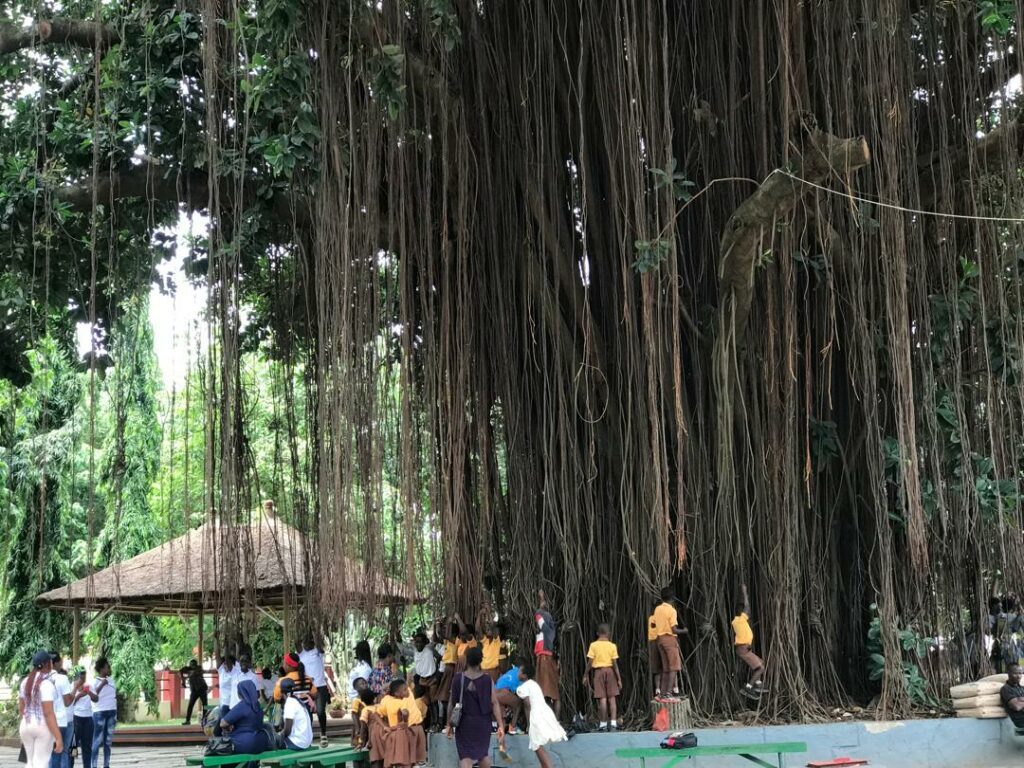
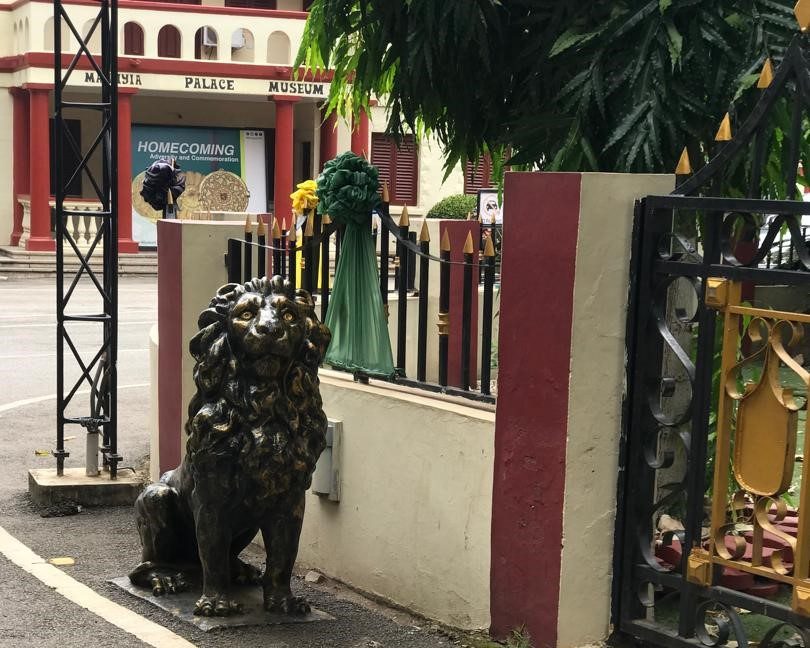
Manhyia Palace Museum
The Manhyia Palace Museum housed in a building which was built in 1925 by the British Government for Asantehene, Prempeh I, as his private residence after he had returned from exile in the Seychelles Islands in 1924 as a replacement for the Asantehene’s palace at Adum that was destroyed during the Yaa Asantewaa war. However, since the Asantes still recognized him as their King, they paid for it and it became the “Ahenfie” (Palace). It was still the Manhyia Palace during the reign of Sir Osei Agyeman Prempeh II.
Since 1970 when the last occupant (Sir Osei Agyeman Prempeh II) died it was left unoccupied. It was renovated and made the Manhyia Palace Museum on 12th August 1995. It houses the historical and rich cultural history of the Asantes as well as their Kings in photographs, artifacts and statues that are communicated to the world (Plates 5.10e and 5.10f) and it is itself an exhibit.
Komfo Anokye: The Golden stool and the sword
At Adum stands the magnificent statue of the great priest of the Asante Kingdom, Komfo Anokye. komfo Anokye, original name Kwame Anokye Frimpong Kotobre was a fetish priest (traditional spiritual leader) and cofounder of the Asante empire who was considered to be the greatest lawgiver and wisest sage of the Asante people.
He is believed to have conjured the golden stool from the sky. This was during a process to select the first king of the Asante Kingdom. The stool is said to have landed on the laps of Osei Tutu who then became the 1st king of the Asantes.
The Golden Stool ” Sikadwa Kofi”
The Golden Stool is a curved seat 46 cm high with a platform 61 cm wide and 30 cm deep. Its entire surface is inlaid with gold and hung with bells to warn the king of impending danger. As a symbol of nationhood, and because it contains the soul of the Asante, the Golden Stool is considered to be so sacred that no person whatsoever is allowed to sit on it. It’s rarely seen but occasionally outdoored during major functions of the King such as the Akwasidae festival.
Komfo Anokye sword site
Situated on the grounds of the Komfo Anokye Teaching Hospital, Kumasi, is the Komfo Anokye Sword Site which is seminal in Asante history. The over 300 year old sword wedged in the rockface is one of the the centre artefacts and legends of the rich history of Kumasi. The Sword site is the exact place where the Golden Stool of Asanteman descended unto the laps of King Osei Tutu I, “Opemsuo” the founder of Asante Nation. The site was predicted by Okomfo Anokye to be a healing place for millions of people. Lo and behold, the site happens to be the exact place where the Komfo Anokye Teaching Hospital is situated.
Kejetia Bus terminal and Central market
The Kejetia market (Kumasi Central Market) is an open-air market in the city of Kumasi, the capital of Ashanti. Open 24 hours a day, this market is home to more than 10,000 traders.
Known as the largest open air market in West Africa, Kejetia market is referred to as the commercial heart of Kumasi. More than 12,000 stalls open each day for business such as clothing’s, handmade glass beads, Ashanti sandals and so many souvenirs.
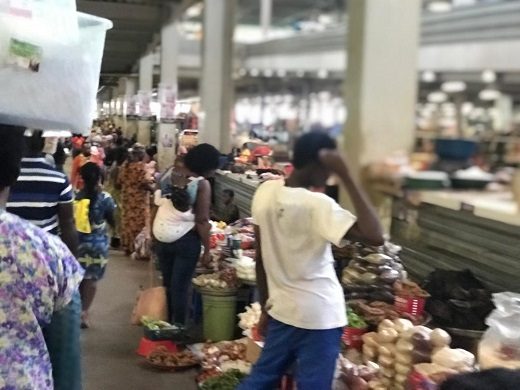
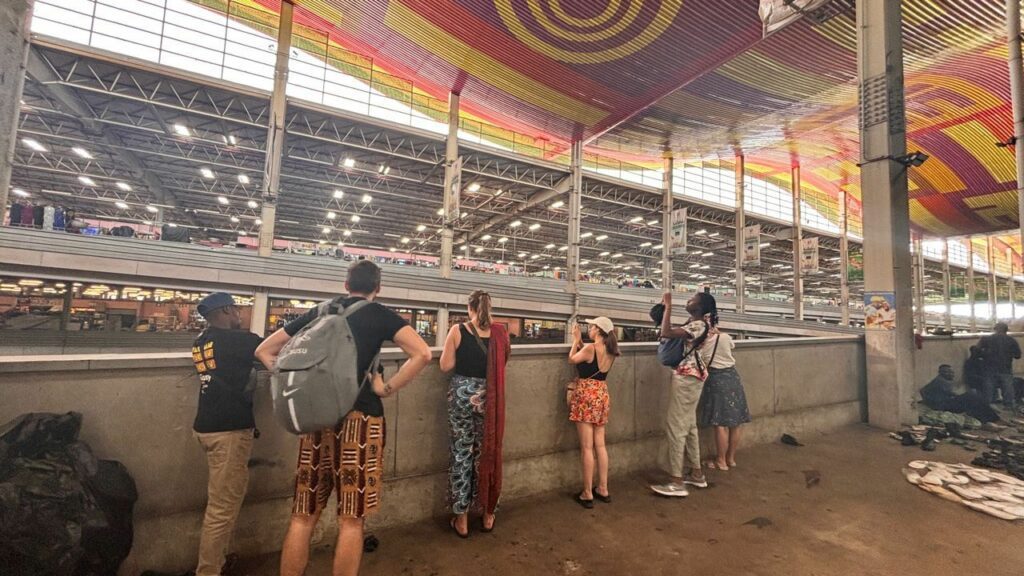
Kejetia market, the center of Kumasi
It is right in the heart of Kumasi as one of West Africa’s largest open air markets. It is bordered to the north by the Kumasi Cultural Centre and to the north-west by the Komfo Anokye Teaching Hospital. The southern part of the Kejetia market forms a border with Adum, the commercial centre of the city. Virtually everything that one wants to purchase from a market can be found at Kumasi Central Market.
Kejetia market ranges from gold jewelry and diamond jewellery handcrafted by the Asantes, food, Ashanti kente clothing fabrics and footwear, spices, grains, and toiletries. If a person is traveling with someone, it is necessary to stay close since it is very easy to lose one another and easy to lose one’s way. Kejetia market is a great place to buy fabric such as the Ashanti people’s kente clothing, and see a huge Kejetia market, full of everyday hustle and bustle.
The Kejetia Bus Terminal is the biggest bus terminal in Ghana. It has vehicles connecting every major city and town in Ghana.
Center for National culture, Kumasi
The Kumasi Center of National Culture is located in the Kumasi city cente. It is about 5 minutes walk from the Bantama Royal Mausoleum and 5 minutes walk from the Kejetia Market. The Centre provides a good account of the rich Ghanaian culture, and also provides evidence of the Asante Kingdom’s eminent past.
It houses the Prempeh II Jubilee museum, which provides a fascinating collection of Asante’s history such as memorabilia of Okomfo Anokye, including the 300 years old antique treasure bag which he barred anyone from opening.
Kumasi Zoological Gardens
The Kumasi Zoological Gardens is the premier zoo in Ghana.
The Kumasi Zoological Gardens (KZG) was established alongside the Cultural Centre in July 1957 as a result of the need to preserve our culture and the most cherished wildlife heritage.
Located in the center of the Kumasi city, the zoo, which occupies 11,000 hectares equivalent to 26 acres, was initially managed by the Kumasi Municipal Council and transferred to the Forestry Service in October 1963, then handed over to the Game and Wildlife Department and currently under the management and supervision of the Wildlife Division of the Forestry Commission.
The KZG currently has a total of 162 individual animals and 46 different species made up of cats, reptiles, ungulates, primates, rodents, birds, including the noticeable hundreds of bats that are not originally part of the zoo but are being protected by the facility.
The Akwasidae Festival
The Akwasidae festival is the festival of the Asantes. It is celebrated every 42 days in the traditional calendar of the Asantes. The festival glorifies the milestones in the history of the Ashanti Kingdom. Its first celebration was during the attainment of statehood by the Ashanti kingdom – after it defeated the Denkyiras in the battle of Feyiase, also known as the Ashanti independence war. During the festival the rich cultural heritage of the Ashanti people is all shown up to attract local and visitors. It often falls on Sundays. During the festival, all the chiefs and traditional authorities under the Asante Kingdom come from near and far to pay homage to the King.
The day revolves around the worship of ancestors
The rites on this day relate to honouring personal and community ancestors. A gathering called Akom occurs in which drumming, dancing and singing are a normal celebration to honour Abosom (lesser gods in the Akan tradition) and Nsamanfo (spiritually cultivated ancestors). Food offerings include special items such as eto (mashed African yam), garnished with hard-boiled eggs.
On this day, the Asantehene (King of Ashanti) meets his subjects and subordinate chiefs in the courtyard of the Manhyia Palace. The Golden Stool (throne) is displayed at the palace grounds in the presence of the king, and people visit in large numbers, singing and dancing. The king holds his durbar on the occasion of the festival, and people have the liberty to shake hands with him.
The Akwasidae Festival is the Asantes’ festival, celebrated every 42 days in the traditional Asante calendar. The festival commemorates milestones in the history of the Ashanti Kingdom. The first celebration marked the achievement of statehood by the Ashanti Kingdom after defeating the Denkyiras in the Battle of Feyiase, also known as the Ashanti Independence War. The festival showcases the rich cultural heritage of the Ashanti people to attract locals and visitors alike. It often falls on a Sunday. During the festival, all chiefs and traditional authorities under the Asante Kingdom come from far and wide to honor the king.
Before holding the durbar, the king goes in a procession in a palanquin decorated with gold jewelry. He also witnesses a colourful parade, from his palace grounds at Kumasi. Participants of the parade include drum beaters, folk dancers, horn-blowers and singers. As it is festival of paying respect to ancestors, the king visits the Bantama Mausoleum and offers worship not only to his ancestors’ chairs (stools), but also to the skeletal remains of his ancestors. It is argued that, the king do not worship the stools and the ancestors, however to pay them homage.
Drumming and dancing; Adowa and Kete dance
Drumming and dancing is key part of the Asante culture. Especially drumming was used in the past to communicate to the Asante people. In every occasion of the Asantes from funeral to festivals, drumming and dancing feature prominently. The Adowa and Kete dances are two of the prominent dances of the Asantes.
The adowa and kete dances are a spectacle to watch. It is beautiful and its rhythm is a gorgeous sight to watch. When you visit Kumasi, you are likely to witness some of these beautiful dances.
Kente cloth
The Kente cloth is hand woven and predominantly produced by the Asantes. The term kente comes from the word ‘kenten’, which means ‘basket’ because the first cloths were woven out of raffia and were dubbed ‘basket cloths’ with patterns resembling those of a basket. Each cloth design has a deep symbolic meaning and is used to provide a social and political commentary. It is also a visual representation of moral, social, ethical, philosophical values, history, social code of conduct and religious beliefs.
In Kumasi and its environs especially in Bonwire, kente cloth is woven. The Kente cloth is now worn at marriage ceremonies, academic graduation ceremonies, funerals, naming ceremonies and now a symbol for the “Black Lives Matter” Movement.
From BW) Hostel you can make day trips to Bonwire and Odomankoma, where they weave Kente for the royal family.
Adinkra symbols
Adinkra symbols are the traditional symbols of the Asante (also known as Ashanti) culture. Each symbol represents an ideal or belief, along with a proverb held by the Asante people. For instance, the symbol below is called Akokonan (“the leg of a hen”); it represents mercy and nurturing, as it recalls the proverb “The hen steps on her chicks but does not hurt them.”
Today, the most common use of Adinkra is still in textiles. The Asante use a traditional stamping process to create cloth that is worn to ceremonies and festivals. The colors of the cloth and the symbols it features represent the sentiments of the event. At funerals, for instance, individuals will adorn themselves with black, brown, or brick-colored cloth that is stamped with symbols pertaining to mortality or religion. In Kumasi, the Adinkra textile business is booming employing a lot of people, both males and females.
Modern Kumasi and why you should visit this African city
The present day Kumasi still maintains its original rich heritage with a blend of modernity. Indeed, it boasts of 1700 kilometer of road networks, ultra modern 5-star hotels, malls, restaurants and eateries and markets. Significantly, the people in Kumasi are some of the most hospitable in Ghana.
I hope you enjoyed the tour.
Kumasi Excursion from BWO Hostel
A day trip to the city is a must when visiting BWO Hostel and the Ashanti region. It is part of our Ultimate Experience Ashanti tour, but even if you are at BWO Hostel as a volunteer or just to relax for a few days, we are happy to organize an excursion to Kumasi for you.
Start at Manhyia Palace
We begin the day at Manhyia Palace, the residence of the King of the Ashantis. If you want to learn more about the history of the Ashanti people, a visit to the museum is highly recommended. Every 42 days, there is a festival, Akwisadea. If you are in Kumasi at that time, it is definitely worth attending. After the tour and a visit to the souvenir shop, where many books are available, we continue our journey.
Visit to Kejetia Market
After visiting Manhyia Palace, it’s time to explore the immense Kejetia Market. A few years ago, the entire market was renovated, and there is now a huge indoor market alongside the many outdoor stalls. You will be amazed by the sights and sounds. However, keep a close eye on your belongings, as the crowded market can be a haven for pickpockets. If you are looking for something specific, let the tour guide know, and they will take you to the right section.
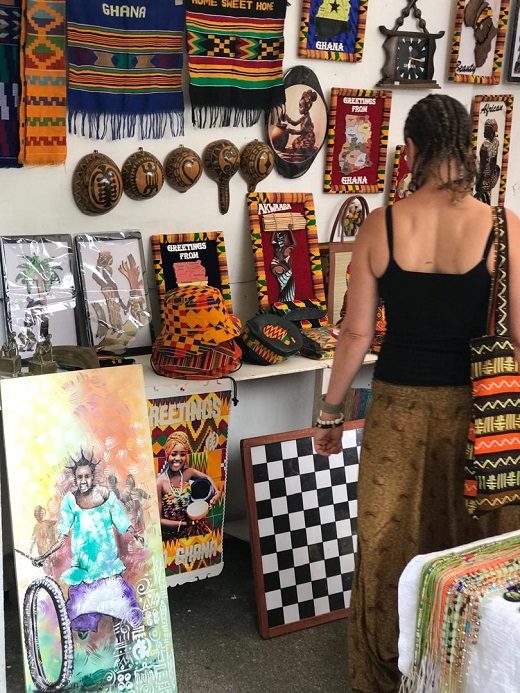
Cultural Centre
Next, we head to the Cultural Centre, an oasis of calm in a bustling city. Even if it starts to rain, it won’t dampen our spirits as we will enjoy a meal at a local restaurant. The Cultural Centre is a beautiful green park with the Prempeh II Museum, shops, and workshops where you can see various Ghanaian items being made. There are potters and woodworkers, among others. In the summer months (July and August), there is a fair.
A part of Modern Kumasi
If there is enough time and energy, we will conclude with a visit to modern Kumasi. Kumasi Mall is one of the many faces of this cosmopolitan city, offering numerous places worth visiting. We choose to shop in the large, cool supermarkets and beautiful stores before heading home. I take the opportunity to stock up on plenty of vegetables.

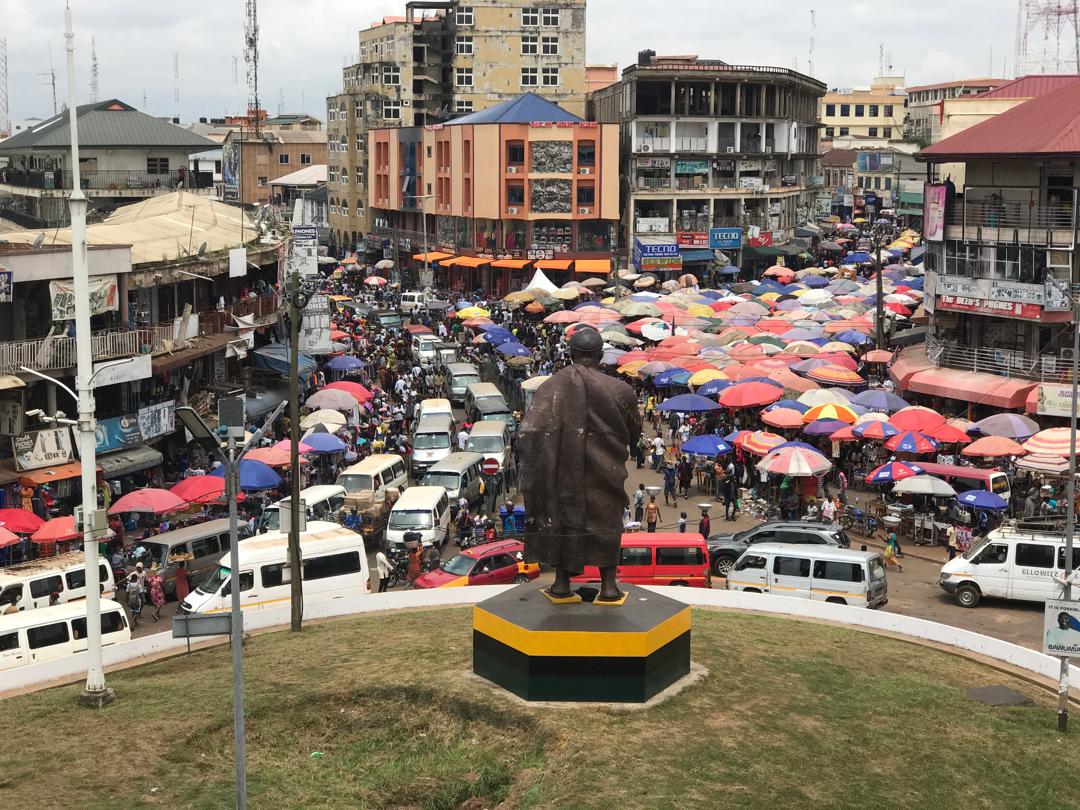
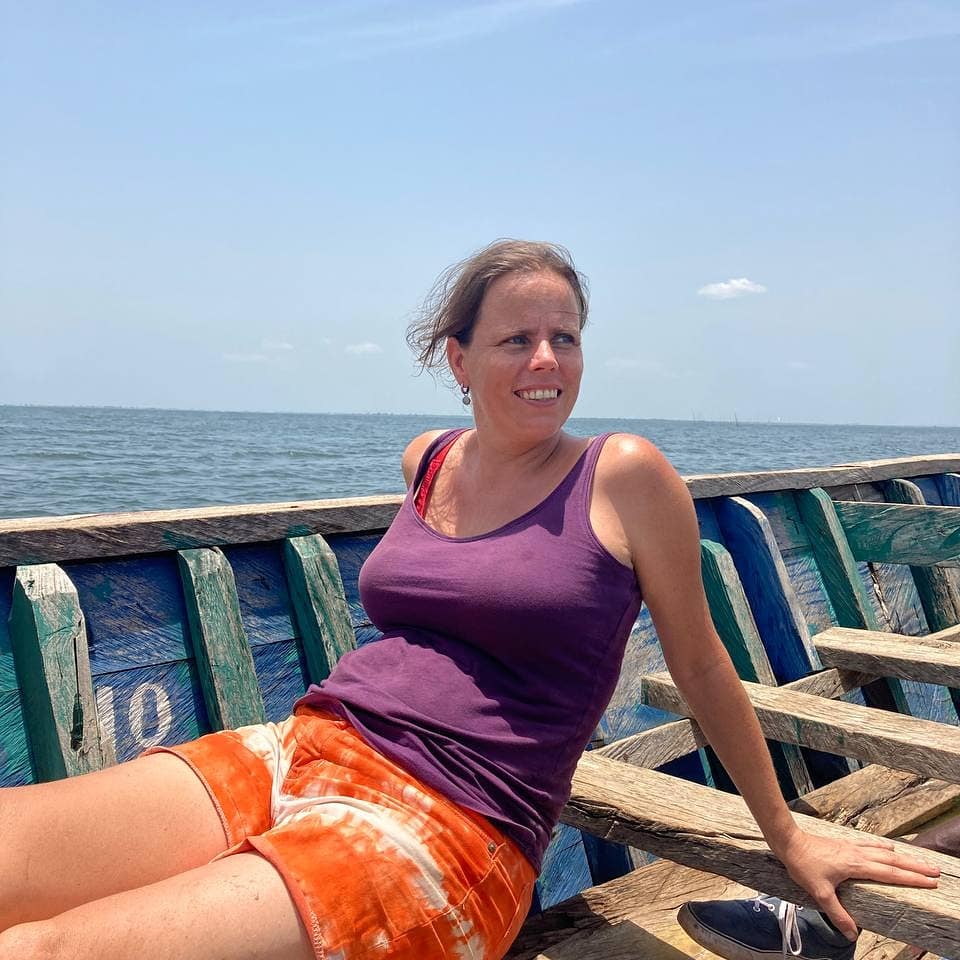

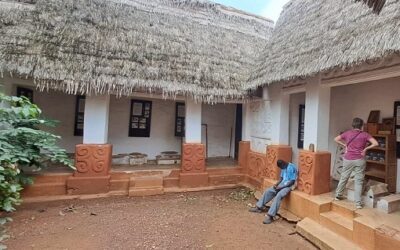

0 Comments